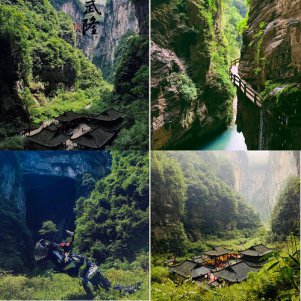[2005第一期]加蓬外长故乡情
[2005第一期]加蓬外长故乡情
2005年07月18日
浙江在线新闻网站
前几天,浙江温州市鹿城区区长王超俊带领该区临江镇的几位乡亲,携着一件雕刻着临江镇驿头山水风光的巨幅黄杨木雕《溪山故宅图》,送到大西洋沿岸的非洲加蓬共和国,将这件珍贵的礼物转到现任第59届联大主席、祖籍浙江省温州临江镇驿头村的加蓬外长让·平手中。这件黄杨木雕作品由温州著名黄杨木雕大师叶萌春创作,高1.5米,宽1.2米,该作品以让·平外长在驿头村的祖居地为创作对象,背景以驿头地方优美秀丽的山川景物作衬托,大方雅致。东方祖居的山川风物,不仅使让·平外长思慕故园之情得以慰藉,同时还牵出了这位有着中国血缘的外长多年来与浙江温州祖籍的绵绵情缘——
三次寻根叙亲情
让·平外长的祖籍在浙江温州鹿城区临江镇驿头地方。上个世纪20年代,让· 平的父亲程三康就是从瓯江南岸这个风景秀丽的山村起步,到达欧洲、非洲开拓他的事业的。七八十年过去,海天相隔,人事渺茫,驿头地方已经很少有人记得这件事了。然而在1994年9月初,一个让人们惊诧不已的消息忽而在驿头地方传扬开来:非洲加蓬共和国外交与合作部部长不日要来驿头地方寻根问祖和探望他的伯母孙老太太。一些不明就里的人便在猜测:莫非是谣传吧?就算有这人,七十来年了,三康老(乡人对让·平外长父亲的昵称)都没回来过一趟,他这个素昧平生的儿子能回来吗?
然而事实总是事实。当年的9月17日,一位年龄50开外、黑皮肤、卷头发、高大的外国人还是带着他父亲生前的嘱咐,携妻带子踏上了温州驿头的行程,他就是加蓬共和国外长,温州乡人习惯在他的名字前加姓氏呼为“程让平”的让·平。
虽然语言不通,肤色不同,但让·平对故乡对亲情的深沉眷念并未因此有一丝削减,这位外长一进村,就直奔他父亲祖辈当年生活过的祖居,与从未谋面的孙老太太等家人亲切相见。祖居是一座古朴而具有浙南民居特色的二进老宅,宅里迎接他的父老乡亲早已济济一堂。让·平外长平易近人,他一一与这些朴实的乡人们打招呼、拥抱,以表达心中积蓄已久的感情。当他来到70多岁的老农程青权跟前,得知他是与父亲辈分相同的长辈时,热情地与这位衣着陈旧、满脸皱纹的乡下老汉深情地拥抱。事后,他带着一片真情,向程青权等人打听,自己在当地程氏家族中属于哪一辈?并嘱咐大家好好生活,注意身体,他以后还要来看望他们!祖居里物是人非,但留有外长先人的许多生活痕迹:在古香古色的木床前,他踟蹰停留,留影纪念;在后厅,他看到手摇式风车,也饶有兴致地动手摇了起来;看到墙边的大酒瓮,他伸手拍一拍……祖居里一件件家什农具,不仅勾起让·平外长对先人的思念,还激起这位海外华裔对东方乡土生活的兴趣,他不住地说: “我今后还会来!”
自1994年让·平外长来临江驿头寻根以后,这位外长又于2000年4月、2003年秋天两次来故乡省亲问祖。每次回故乡,都增加了他对故乡的一份深情、一片爱意。
他祭拜祖坟,缅怀先人的业绩;
他为驿头小学捐资1万法郎,帮助学校修缮校舍;
他展望家乡的秀美景色,表示愿意出资金在村口建"中加友谊亭",加深中国温州与加蓬国家的友谊。
……
驿头风物耐寻味
让·平外长除了对故园人情亲情的系挂之外,他对温州驿头的山水、风俗和文化更是眷恋和向往。
早在1986年让·平任加蓬民主党中央委员时,一些在加蓬经商的驿头乡人告诉他,温州家乡有修氏族家谱的风俗,程氏家族也要修族谱,问他是不是也将名字列入谱中。当他理解了温州风俗中修撰宗谱的意义以后,欣然答应,于是,让·平的名字载入了驿头程氏的家谱里。不过按族中排辈,让·平这一辈属“正”字辈,又因为他身居国外,属华侨眷,故族中父老按辈分给他取名为“程正侨”。现在所见 1986年修撰的驿头程氏房谱里,赫然有“正侨”这名字,这便是加蓬外长让·平在故乡的“符号”。
在以后的回浙江温州故乡寻根问祖活动中,让·平对温州的风土人情钟情有加。他第一次来温州驿头寻根,就要求侄女程秀萍将带有浓厚地方乡土文化特色的《程氏族谱》给他也复印、翻译一份,他要将家谱带往海外好好把玩。
在驿头一处幽静的山边,竖有一座明朝成化十九年泐刻的“圣旨”石碑。该碑文旌表的,是当年程家祖先程奕慷慨为民的尚义之举。2003年10月份,让·平外长应邀回温州参加世界温州人大会,再一次踏上了驿头这个祖居之地。在驿头,他游历了矗立瓯江中的西州岛等驿头山水,也来到这座被当地呼为“圣旨亭”的碑亭前。他一边欣赏着古碑,一边听着父老乡亲介绍碑中的内容,景仰之情油然而生,他对周围的人说:自己为有这样一位有业绩的祖先而自豪!随后他在碑前拍照留影,说要带回去留念。
这次让·平外长回驿头探亲期间,踏遍了驿头的每个角落,还为一些地方名胜题字,这位华裔政治家此时此刻已经沉醉在故乡山水和乡情里。
故乡礼物寄情思
海外华裔对故乡的眷恋,也引起了故乡父老乡亲的共鸣。为慰藉这位华裔外长的思乡之情,去年7月份,临江当地政府和驿头地方父老乡亲们商量给他送一件家乡纪念品。经过多次讨论,最后大家决定制作一件带有温州地方民间艺术特点的黄杨木雕,将家乡驿头地方的山水雕刻上去,以让这位外长随时可以看到故乡的山山水水。乡人紧张地忙碌开了,购材料的购材料,找工匠的找工匠,同时还找来摄影师将外长的驿头祖居及四周风貌一一拍摄制成风光照片,并请温州著名的黄杨木雕艺术家叶萌春负责这件巨制的创作。
经过两个多月的紧张忙碌和精心制作,这件庞大而精美的木雕山水作品问世了!作品将驿头的溪山、古宅和风貌描绘得维妙维肖,接着大家又请颇具儒雅风度的鹿城区区长王超俊题词。王超俊欣然命笔,他引用了唐朝大诗人杜甫《宿白沙驿》诗里的诗句:“驿边沙旧白,湖外草新青”,点出了瓯江南岸驿头清新秀丽的自然风光。
而今,驿头的父老乡亲和鹿城区、临江镇政府,带着一片故乡亲情谊,已将这件黄杨木雕作品送到了加蓬,让·平外长当即欣喜地将它安置在自己的办公室里,他从此可以时刻观赏故乡的山山水水了。
Foreign Minister's Chinese Root in Wenzhou
By Zhuang Qianhui, Yu Dongqing
Just the other day, a Chinese delegation brought a large-size boxwood sculpture all the way to the Gabonese Republic and presented the gift to Jean Ping, foreign minister. Headed by Wang Chaojun, a government head of Lucheng District of Wenzhou in southern Zhejiang Province, the delegation consisted of hometown people of Jean Ping.
Jean Ping's father was Cheng Sankang. It was from Yitou village on the picturesque southern shore of Ou River that Cheng Sankang set out to try his luck in Europe and Africa in the 1920s. After about seven decades, few in the village still remembered their fellow villager who had ventured overseas. Villagers were surprised to hear in early September 1994 that the foreign minister of Gabon would come to visit his aunt in Yitou. Some villagers wondered if the news was true. Their doubt sounded justifiable: if Sankang had never come back, how come his son could make up his mind for homecoming?
Jean Ping arrived on September 19th 1994. Dark skinned with curly hair, the tall African in his 50s came together with his wife to seek roots in Yitou. Local people called him Cheng Rangping.
Jean Ping went straight to the ancestral house where his father once lived and where his relatives still live today. In the two-section courtyard his relatives were waiting. The reunion was quite emotional. Jean Ping hugged all his relatives. And he asked about his own position in the family hierarchy. Then his relatives took the visitors around to see the house and courtyard. Jean Ping saw the large-size bed and took pictures there. He turned a winnower and gently shook a wine jar curiously. He said he was quite interested in things in his home village and promised to come back again.
He came back again in April 2000 and in the autumn 2003. He visited his ancestral tombs. He donated 10,000 Francs to Yitou Primary School. He said he would like to donate money to have a pavilion built in the village to promote the friendship between China and Gabon.
As far back as in 1986, Jean Ping learned from business people from Yitou in Gabon that families in Wenzhou have the tradition of writing their family histories. Jean Ping was asked whether he would like to have his name added to his family genealogy back home in Wenzhou. After learning about the tradition, Jean Ping agreed willingly. As Jean Ping belongs to the generation whose first Chinese character of the given name is Zheng and he is overseas, so he is known as Zhengqiao in the book.
During the first visit to the village, he asked his niece to have the family genealogy translated and copied so that he could bring it home in Gabon.
In a quiet hillside of Yitou village stands a stele. It was erected in the Chenghua period of the Ming Dynasty (1364-1644) under the instruction of the royal court. On the stele is an imperial decree by the emperor that praised an ancestor of the Cheng Family for his generous deed for local people. In October 2003, Jean Ping visited the stele during his participation in the World Wenzhou Natives Congress held in Wenzhou. He also toured the nearby scenic spots and was deeply impressed by the scenery.
In July 2003, the home village people decided to make a souvenir for Jean Ping. After many sessions of discussion, it was decided that the Yitou scenery should be made into a boxwood sculpture so that the foreign minister could see his hometown at anytime in Gabon.
After two months, the sculpture came into being. The picturesque village with its streams and hills is all on the wood-carving masterpiece. Wang Chaojun was asked to inscribe. He chose two lines from a poem by Tang Dynasty (618-907) poet Du Fu and wrote the ten characters in calligraphy.
It has been delivered to Jean Ping's office in Gabon, where he can look at the sculpture everyday.
(Translated by David)
图说文字:
[2005第一期]加蓬外长故乡情:https://www.2ndflr.com/dm/jiapeng/924467.html
相关问答
周边城市地名
利伯维尔 让蒂尔港 弗朗斯维尔 莫安达 兰巴雷内 穆伊拉 奇班加 马科库 库拉穆图 奥耶姆 河口 上奥果韦 中奥果韦 恩古涅 尼扬加 奥果韦-伊温多 奥果韦-洛洛 滨海奥果韦 沃勒-恩特姆









